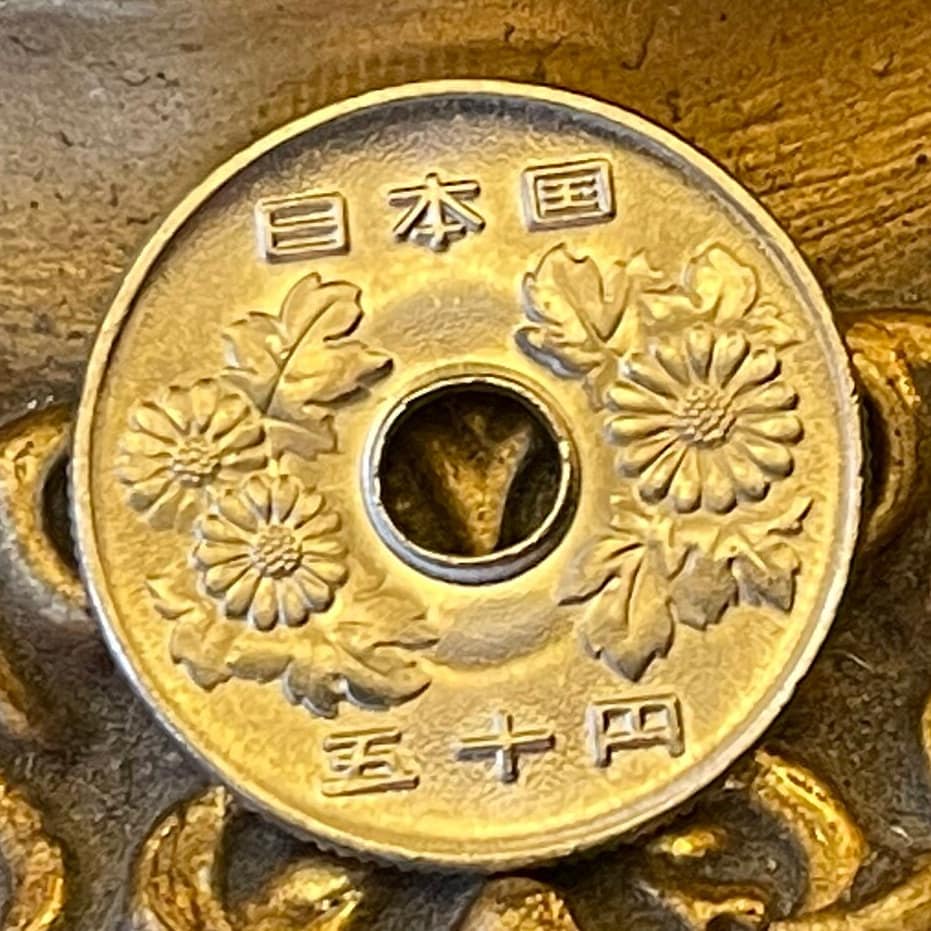elemintalshop
Chrysanthemums 50 Yen Japan Authentic Coin Money for Jewelry and Craft Making (Hole in Coin) (Imperial Family) (Kiku) (Longevity) (Nobility)
Chrysanthemums 50 Yen Japan Authentic Coin Money for Jewelry and Craft Making (Hole in Coin) (Imperial Family) (Kiku) (Longevity) (Nobility)
Couldn't load pickup availability
Chrysanthemums 50 Yen Japan Authentic Coin Money for Jewelry and Craft Making (Hole in Coin) (Imperial Family) (Kiku)
Obverse: Center hole flanked by chrysanthemum flowers, authority at top and value below
Lettering:
日 本 国
五 十 円
Translation:
State of Japan
50 yen
Reverse: Value in large font above the center hole with the date below
Lettering: 50
平 成 4 年
Translation: 50
Year 4 of Heisei
[example of year -- each coin may have different years)
Features
Issuer Japan
Emperor Heisei (1989-2019)
Type Standard circulation coin
Years 1-31 (1989-2019)
Calendar Japanese - Heisei era
Value 50 Yen
50 JPY = 0.45 USD
Currency Yen (1871-date)
Composition Copper-nickel
Weight 4 g
Diameter 21 mm
Thickness 1.7 mm
Shape Round with a round hole
Orientation Medal alignment ↑↑
Number N# 2120
References Y# 101, JNDA# 02-7, Schön# 75
The chrysanthemum represents longevity, rejuvenation and nobility in Japan. It is also the symbol of autumn, harvest and goodwill. Because of its auspicious meaning, the flower frequently appears on decorations, accessories, porcelains, kimonos and obis, as well as Japan's 50 yen coin. People give red chrysanthemums to loved and respected people. But be careful; do not give white chrysanthemum as gifts because it is used for funerals and graves in the country.
Source: https://news.cgtn.com/news/2019-09-10/The-chrysanthemum-culture-in-Japan-beautiful-auspicious-and-royal-JSbIPUG5Ve/index.html
Wikipedia:
Chrysanthemums first arrived in Japan by way of China in the 5th century. The chrysanthemum has been used as a theme of waka (Japanese traditional poetry) since around the 10th century in the Heian period, and Kokin Wakashū is the most famous of them. In the 12th century, during the Kamakura period, when the Retired Emperor Go-Toba adopted it as the mon (family crest) of the Imperial family, it became a flower that symbolized autumn in Japan. During the Edo period from the 17th century to the 19th century, due to the development of economy and culture, the cultivation of chrysanthemums, cherry blossoms, Japanese iris, morning glory, etc. became popular, many cultivars were created and many chrysanthemum exhibitions were held. From the Meiji period in the latter half of the 19th century, due to the growing importance of the chrysanthemum, which symbolized the Imperial family, the creation of ogiku style cultivars with a diameter of 20 cm or more became popular.
In the present day, each autumn there are chrysanthemum exhibitions at the Shinjuku Gyo-en, Meiji Shrine and Yasukuni Shrine in Tokyo. The Yasukuni Shrine, formerly a state-endowed shrine (官国弊社, kankokuheisha) has adopted the chrysanthemum crest. Culinary-grade chrysanthemums are used to decorate food, and they remain a common motif for traditional Japanese arts like porcelain, lacquerware and kimono.
Chrysanthemum growing is still practised actively as a hobby by many Japanese people who enter prize plants in contests. Chrysanthemum "dolls", often depicting fictional characters from both traditional sources like kabuki and contemporary sources like Disney, are displayed throughout the fall months, and the city of Nihonmatsu hosts the "Nihonmatsu Chrysanthemum Dolls Exhibition" every autumn in historical ruin of Nihonmatsu Castle. They are also grown into chrysanthemum bonsai forms.
In Japan, the chrysanthemum is a symbol of the Emperor and the Imperial family. In particular, a "chrysanthemum crest" (菊花紋章, kikukamonshō or kikkamonshō), i.e. a mon of chrysanthemum blossom design, indicates a link to the Emperor; there are more than 150 patterns of this design. Notable uses of and reference to the Imperial chrysanthemum include:
The Imperial Seal of Japan is used by members of the Japanese imperial family. In 1869, a two-layered, 16-petal design was designated as the symbol of the emperor. Princes used a simpler, single-layer pattern.
The Chrysanthemum Throne is the name given to the position of Japanese Emperor and the throne.
The Supreme Order of the Chrysanthemum is a Japanese honor awarded by the emperor on the advice of the Japanese government.
In imperial Japan, small arms were required to be stamped with the imperial chrysanthemum, as they were considered the personal property of the emperor.
The Nagoya Castle Chrysanthemum Competition started after the end of the Pacific War. The event at the castle has become a tradition for the city. With three categories, it is one of the largest events of its kind in the region by both scale and content. The first category is the exhibition of cultivated flowers. The second category is for bonsai flowers, which are combined with dead pieces of wood to give the illusion of miniature trees. The third category is the creation of miniature landscapes.
Share










Very fast shipping, coins looked just like the pictures
Great seller. She worked with me to save postage and make sure I got what I wanted.
The item matched the description and met my expectations
5 stars review from Hussain










